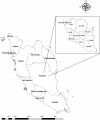The detection of pfcrt and pfmdr1 point mutations as molecular markers of chloroquine drug resistance, Pahang, Malaysia
- PMID: 22853645
- PMCID: PMC3493286
- DOI: 10.1186/1475-2875-11-251
The detection of pfcrt and pfmdr1 point mutations as molecular markers of chloroquine drug resistance, Pahang, Malaysia
Abstract
Background: Malaria is still a public health problem in Malaysia with chloroquine (CQ) being the first-line drug in the treatment policy of uncomplicated malaria. There is a scarcity in information about the magnitude of Plasmodium falciparum CQ resistance. This study aims to investigate the presence of single point mutations in the P. falciparum chloroquine-resistance transporter gene (pfcrt) at codons 76, 271, 326, 356 and 371 and in P. falciparum multi-drug resistance-1 gene (pfmdr1) at codons 86 and 1246, as molecular markers of CQ resistance.
Methods: A total of 75 P. falciparum blood samples were collected from different districts of Pahang state, Malaysia. Single nucleotide polymorphisms in pfcrt gene (codons 76, 271, 326, 356 and 371) and pfmdr1 gene (codons 86 and 1246) were analysed by using mutation-specific nested PCR and restriction fragment length polymorphism (PCR-RFLP) methods.
Results: Mutations of pfcrt K76T and pfcrt R371I were the most prevalent among pfcrt gene mutations reported by this study; 52% and 77%, respectively. Other codons of the pfcrt gene and the positions 86 and 1246 of the pfmdr1 gene were found mostly of wild type. Significant associations of pfcrt K76T, pfcrt N326S and pfcrt I356T mutations with parasitaemia were also reported.
Conclusion: The high existence of mutant pfcrt T76 may indicate the low susceptibility of P. falciparum isolates to CQ in Peninsular Malaysia. The findings of this study establish baseline data on the molecular markers of P. falciparum CQ resistance, which may help in the surveillance of drug resistance in Peninsular Malaysia.
Figures
References
-
- WHO. World Malaria Report 2010. Geneva: World Health Organization; 2010.
-
- Young MD, Contacos PG, Stitcher JE, Millar JW. Drug resistance in Plasmodium falciparum from Thailand. Am J Trop Med Hyg. 1963;12:305–314. - PubMed
-
- Harinasuta T, Suntharasamai P, Viravan C. Chloroquine resistant falciparum malaria in Thailand. Lancet. 1965;ii:657–660. - PubMed
-
- Grimmond TR, Donovan KO, Riley ID. Chloroquine resistant malaria in Papua New Guinea. P N G Med J. 1976;19:184–185. - PubMed
-
- Moore DV, Lanier JE. Observations on two Plasmodium falciparum infections with an abnormal response to chloroquine. Am J Trop Med Hyg. 1961;10:5–9. - PubMed



